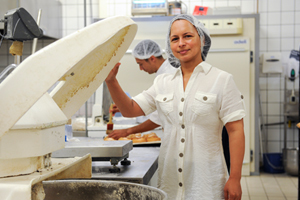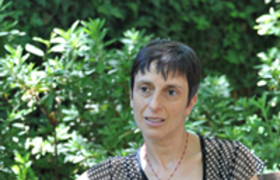Baker's asthma no cakewalk
17 February 2014
Lids for industrial dough mixers, dust masks for bakers, and vacuum cleaners to suck up flour residue on work surfaces.
These were just some of the improvements introduced in a national supermarket chain's bakeries thanks to Dr Roslynn Baatjies' intervention study on baker's asthma, a serious manifestation of occupational allergy among bakery workers.
Baatjies' study was the first of its kind in South Africa and the backbone of her PhD, arising from an interest in environmental health (she has a Master's in Environmental Health from the Cape Peninsula University of Technology, and a master's in Public Health from Wits).
Not long ago her PhD supervisor, Professor Mohamed Jeebhay (School of Public Health and Family Medicine), conducted a study in the fish-processing factories along the West Coast, where workers and fish processors developed allergic reactions after being sensitised by continuous exposure to fish products.
Similar symptoms, caused by cereal flour allergens, were seen among bakery workers. But the problem was largely undetected, and poorly managed as a result.
Bakers produce antibodies as a result of inhaling flour dust allergens. The first signs of allergy are sneezing and rhinitis, associated with exposure to the flour dust, followed by full-scale allergic asthma. Many bakers were taking time off to visit clinics and doctors for medical relief.
This trend was initially reported by Professor Rodney Ehrlich at Groote Schuur's Occupational Medicine Clinic, who recommended a detailed investigation of the problem. Taking up the challenge, Baatjies determined to find out the extent of the disease burden; the level of dust exposure; and importantly, what could be done to safeguard the health of bakers who produce much of the country's specialty breads, rolls, cakes and other baked goods.
"Bakers are highly skilled specialists," Baatjies said. "This supermarket chain needed to address this problem or lose their bakers to allergic illness."
With aid from the company, who were keen to support and fund the research, Baatjies conducted a cross-sectional study of over 500 bakery workers in 31 supermarkets in the Western Cape Metropole and surrounding area.
She measured the flour dust levels of all the main jobs including those of bakers, confectioners, counter hands, supervisors, and managers. This proved to be quite taxing work, among the mixing bowls and ovens, often starting in the early hours with the 02h00 shift. Baatjies also learnt "a lo-o-o-t" about baking (plenty of butter goes onto the shaggy dough that emerges from the oven as a golden, flaky croissant).
The results of her survey demonstrated that bread bakers had the highest dust and allergen exposures, and had the highest risk of developing allergy and asthma from inhaling the flour dust.
To counter this, Baatjies introduced lids on mixer tubs, dust masks for 'dusty' tasks, and better housekeeping routines to minimise flour dust.
Her messages were simple: don't throw flour around like a celebrity chef, use a sieve instead; use oil instead of flour to prevent dough sticking to the kneading board during bread baking (unless it's ciabatta, sourdough bread or Portuguese rolls); and use a vacuum cleaner or sprinkle water on the floor when sweeping, to prevent the flour dust becoming airborne.
Working with the company, Baatjies also developed a dust control manual and a training DVD to educate bakers on how to reduce the dust levels in their work.
But her greatest challenge was to evaluate the effectiveness of the controls introduced. A year later Baatjies reassessed, to see if the interventions had delivered.
It was good news: there was a 50% reduction in average flour dust, wheat and rye allergens in the bakeries. And in bakeries where the lids had been used on the giant mixer tubs, the reduction was even more remarkable – up to 80%.
The supermarket chain will now make mixer tub lids a standard feature in all bakeries, and use the DVD to train all new bakers as part of their induction programme.
Baatjies' study has also provided further insights into the adequacy of airborne flour dust exposure standards to protect worker's health – South Africa has a grain dust standard level 10 times higher than international norms for flour dust.
Baatjies plans to make recommendations to the Department of Labour to revise the current "grossly inadequate" flour dust exposure standard, bringing it in line with international best practice.
On the back of this work is a new, allied project: an investigation into rye flour.
"The bakers complained more about rye flour, which has similar allergens to wheat. We need to investigate to see if there is a difference in effects."
Baatjies hopes to study the long-term impact of how these interventions reduce the asthma disease burden.
Story by Helen Swingler. Image by Micheal Hammond.
 This work is licensed under a Creative Commons Attribution-NoDerivatives 4.0 International License.
This work is licensed under a Creative Commons Attribution-NoDerivatives 4.0 International License.
Please view the republishing articles page for more information.










